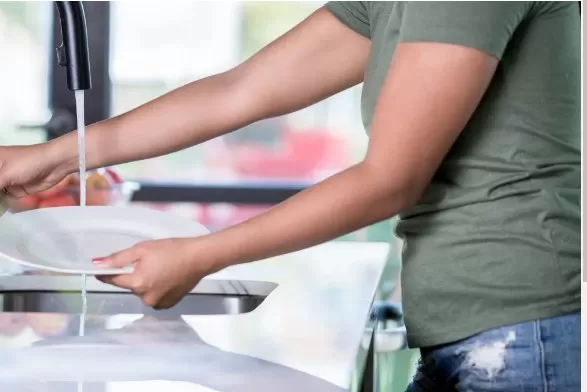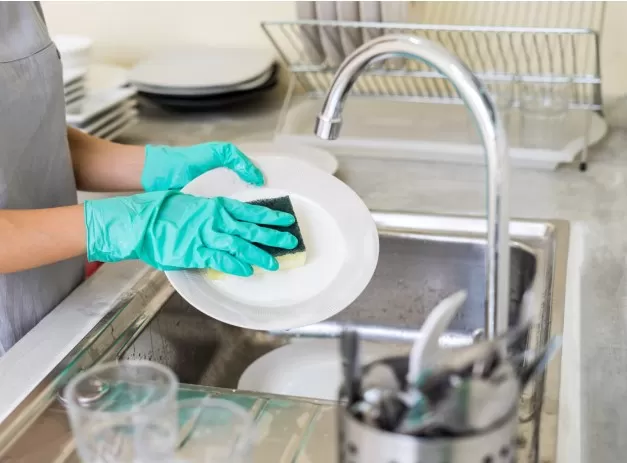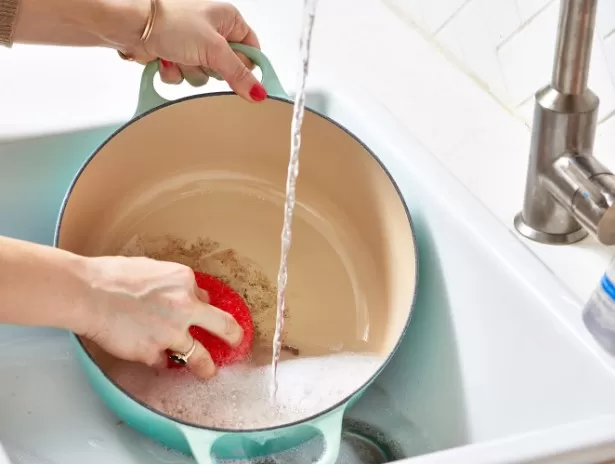Hand-Washing Dishes: Mastering the Right Technique. While your dishwasher can handle most of your kitchen cleaning, certain items require a more gentle touch. Delicate china, wood-handled spatulas, and other fragile pieces should be hand-washed to avoid damage.
“Water force, heat, and detergent can harm these items,” warns Jessica Ek from the American Cleaning Institute. To ensure their longevity, hand-wash aluminum utensils, cast iron, china, crystal, cutlery, decorated glassware, hollow-handled knives, milk glass, pewter, plastics, silver, and wooden items with care.
Essential Steps for Hand-Washing Dishes

When hand-washing dishes, start by gently scraping any leftover food into the trash or garbage disposal using a rubber spatula or paper towel, advises Jessica Ek.
As you place the dishes in the sink, give them a quick rinse. Remember, it’s crucial never to pour grease down the drain to prevent potential clogs.
Effective Techniques for Hand-Washing Dishes
To make dishwashing easier and prevent stains, it’s recommended to soak dishes and cookware before washing.
Jessica Ek suggests adding detergent or baking soda to the sink or dishpan, or directly into the soiled pot, and filling it with hot water. Let them soak for 15 to 30 minutes before draining.
Initiate the soaking process while clearing the dinner table, and by the time you’ve finished your after-dinner cappuccino, your dishes will be ready to wash.
For bone china, Wedgwood advises soaking in vinegar to eliminate hard water spots and using a baking soda and water paste to remove coffee stains and fork marks.
The Efficient Double-Basin Method for Hand-Washing Dishes

For energy-efficient hand-washing, the University of Michigan recommends using the two-basin method.
Fill one sink with hot water for washing and the other with cool water for rinsing. If you don’t have double sinks, use a tub or basin for the hot water and designate the remaining sink area for items ready to be rinsed.
This method conserves energy while ensuring thorough cleaning and rinsing of your dishes.
Achieve Clean and Sanitized Dishes with Hot Water
The temperature of the water you use for hand-washing dishes at home doesn’t need to reach specific regulations for sanitation, according to the FDA.
Clean, hot water along with Dish Soap is sufficient for effectively cleaning your dishware. Ohio State University’s study found that water as cool as 75. 2 degrees Fahrenheit removed bacteria from dishes, and water around this temperature will effectively loosen food and dissolve grease without causing discomfort or drying out your hands.
Choose a mild detergent suitable for delicate items like china and crystal, and be mindful of the suggested amount for proper cleaning.
Use any type of sponge or scrubber, ensuring they are left to air dry or cleaned in the washing machine after each use. Regularly replace sponges and rags to maintain cleanliness and hygiene.
Effective Dishwashing: The Right Order and Technique

To maximize the cleanliness of your dishes and keep the water cleaner for longer, it’s best to wash items from least to most soiled, as recommended by Ek.
Begin with glasses, cups, and flatware, followed by plates and bowls, and then move on to serving dishes and pots and pans. For sharp knives, wash and rinse them individually to ensure safety and prevent them from getting lost in the suds, placing them directly in the drying rack afterward.
Maintain a Steady Flow: Tips for Effective Washing.
To ensure thorough cleaning, keep each dish submerged in the water while scrubbing and periodically lift them to check for any missed spots.
To maintain the effectiveness of your cleaning process, drain the water and start with fresh, Clean Water if it becomes greasy, too cool, or if the suds disappear.
Remember, with the right technique and attention to detail, your hand-washed dishes will sparkle and shine.
Thorough Rinsing for Sparkling Clean Dishes

Flexible Rinsing Methods for Pristine Results.
Once your dishes have been properly washed, it’s time to give them a final rinse to ensure they are spotless and ready to use.
You have several options for rinsing, depending on your available space and preference. According to Ek’s recommendations, you can rinse all your dishes at once or opt for a continuous rinsing approach as you go.
Options for Effective Rinsing.
There are various ways to rinse your dishes effectively.
You can dip them in a rinsing sink or pan, pass them under a stream or spray of hot water, or place them in a drying rack and pour or spray water over them. If you have a double sink, utilize the second sink specifically for rinsing washed dishes.
Remember to pay attention to the insides of cups, bowls, and glassware, ensuring thorough rinsing to remove any lingering residue.
Achieve Sparkling Clean Results with Proper Rinsing Techniques.
By implementing proper rinsing techniques, you’ll achieve spotless and hygienic dishes that are ready to be used or put away.
Choose the rinsing method that works best for your setup, and enjoy the satisfaction of gleaming, ready-to-use tableware.
*The information is for reference only.